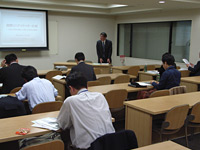 |
 |
|||||||||||||
|
|||||||||||||
|
|||||||||||||
|
On 29 November last year, the Japan Society of Civil Engineers (JSCE) met with the press to explain the activities and present status of their ILC subcommittee, called the Technical Committee on Civil Engineering Issues for Linear Collider Project. The LC subcommittee was launched in June 2006 (See NewsLine 24 August 2006). One of the goals is an active collaboration between civil engineers and physicists to understand the civil engineering aspects for building the ILC in Japan. The subcommittee studies the necessary planning, geological survey, design, construction and maintenance phases for the project. The LC subcommittee is the first collaboration between physics and civil engineering in Japan, and it paves the way for future collaborative research or support. During the press conference, the JSCE received many questions about the status of science and technology in Japan, and especially, the present status and possibilities of civil engineering. In particular, the civil engineers explained that the ILC facilities will consist of twin tunnels of about 40 kilometres in length, a huge underground hall and other facilities such as access shafts and ramps. "We think it is possible to construct these facilities based on our past experiences with underground power plants, underground stowage, roads and railroads," one representative said. "On the other hand, more studies are necessary in areas such as rapid construction techniques, low-cost construction, high-quality drilling without damaging landscape or environment." Atsushi Enomoto (KEK), one of the members of the GDE Design Cost board, said, "When we construct a 40-kilometre long accelerator with the designated precision and construction schedule and cost, we need to build closer cooperation with JSCE and obtain assistance from them in order to solve confronted technical challenges." The participants stressed that this was the first attempt of the collaboration of two very different societies -- physics and civil engineering (mainly rock and tunnel engineering). "Even though both communities speak Japanese, sometimes we felt it is difficult to understand each other, mainly because of the lack of the common technical terms," they said, comparing the experience to attending an international conference for the first time. "We think it is important to bridge the gap: for civil engineers to understand accelerator physicists, and for physicists to understand civil engineering." -- Nobuko Kobayashi |
|||||||||||||
| © International Linear Collider |
